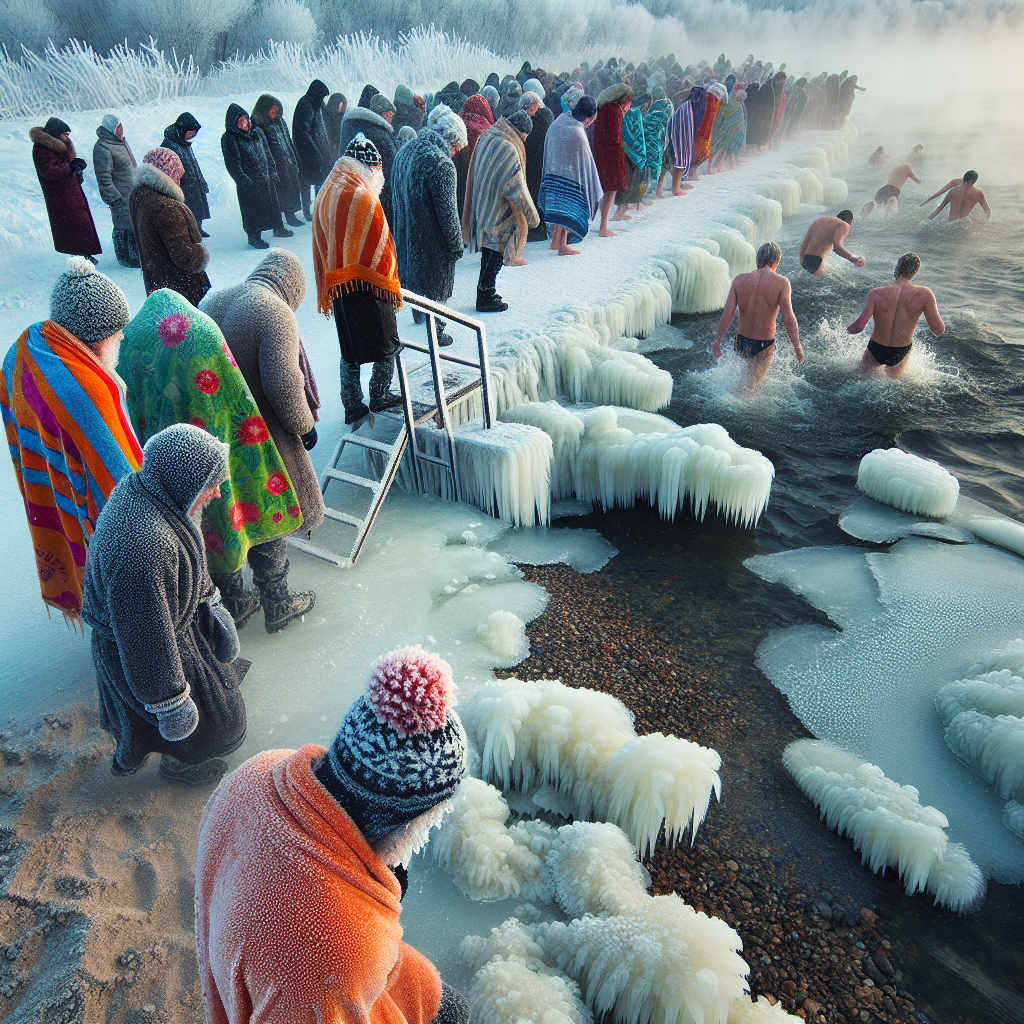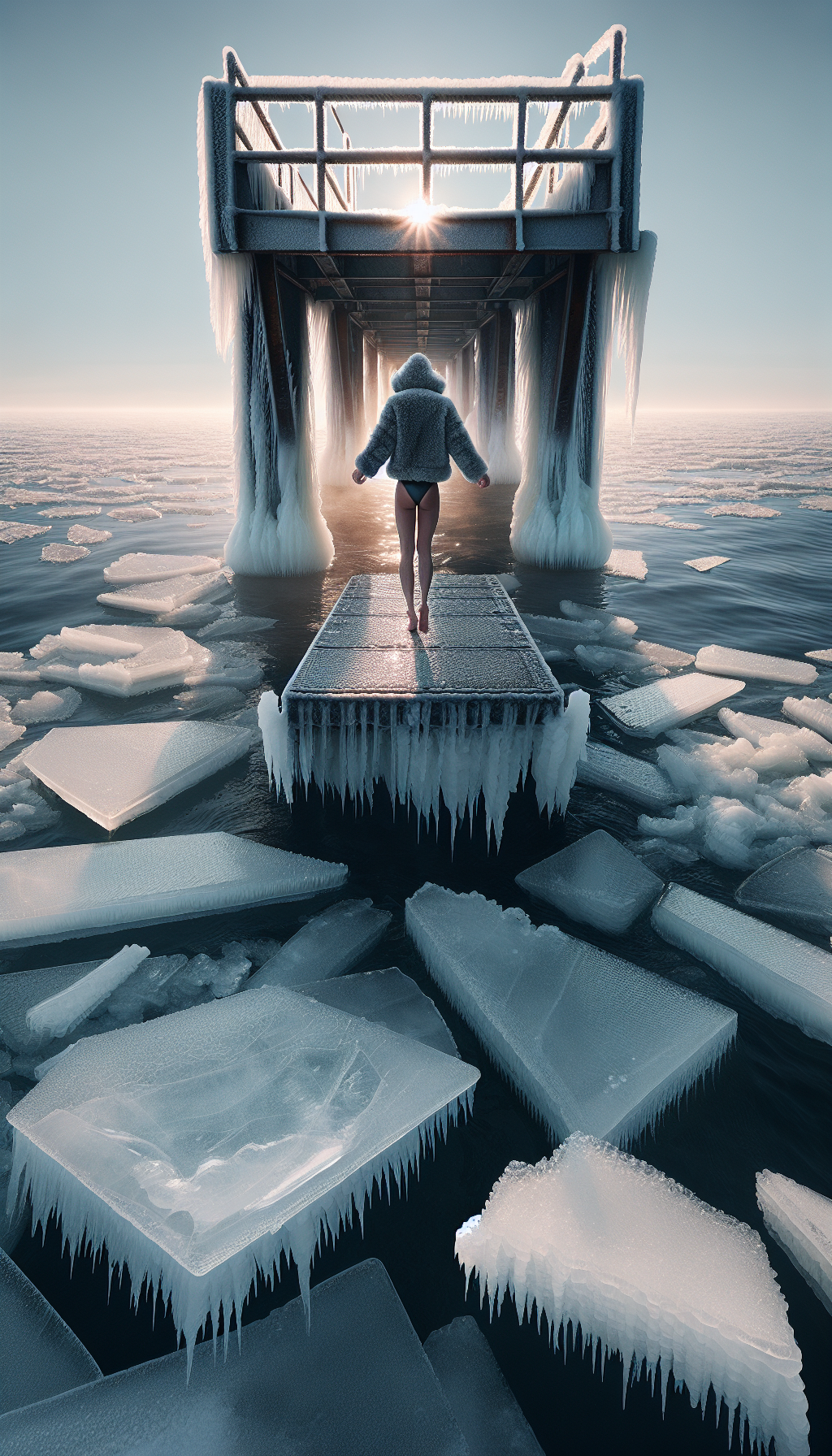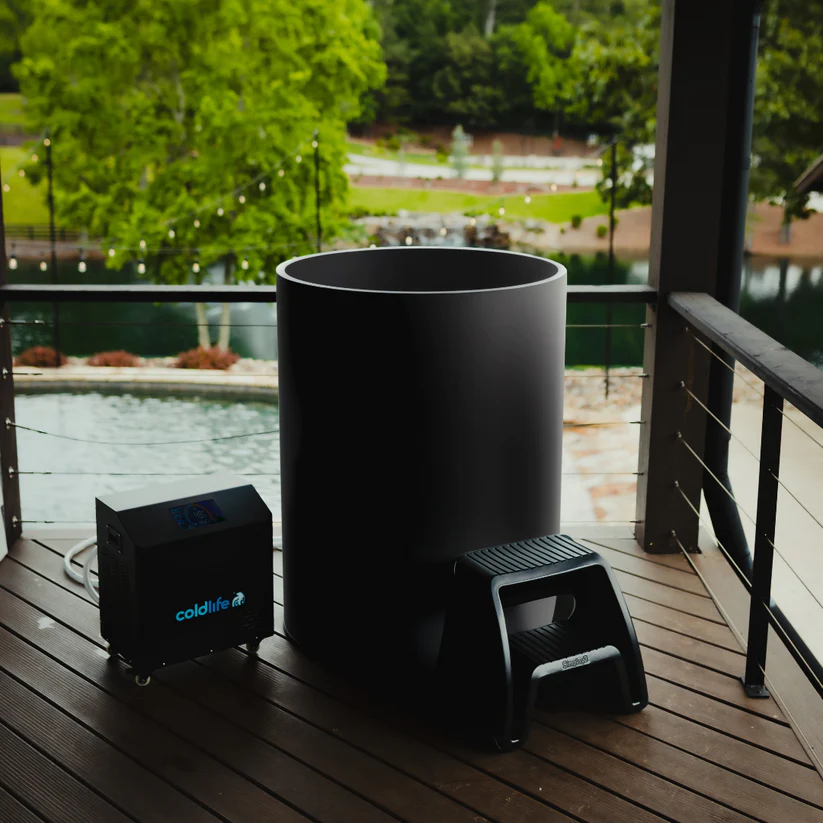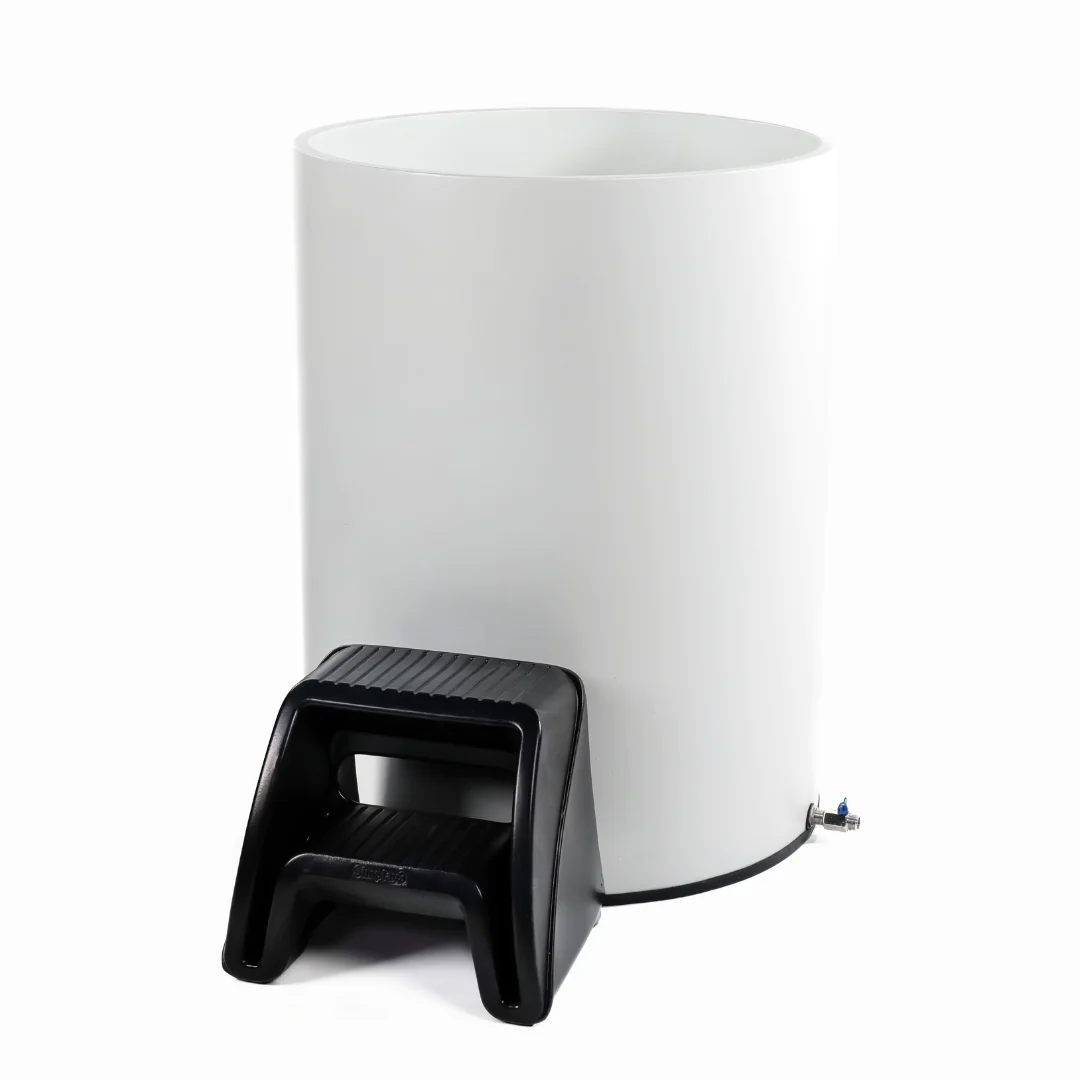Key Takeaways – How cold is too cold for polar plunge?
Takeaway 1: Don’t dive into freezing waters without proper precautions!
Listen, I get it. The thrill of a polar plunge can be irresistible. But let’s not forget that safety should always come first. According to the National Center for Cold Water Safety, jumping into water under 60 degrees Fahrenheit can be seriously risky. Your body loses heat rapidly in cold water, which can lead to hypothermia and other dangerous conditions, especially if the temperature drops below 10°C (50°F). So, make sure you know your limits and aim for water temperatures between 10 to 15 degrees Celsius (50 to 59 degrees Fahrenheit). And here’s a tip: before taking the plunge, give yourself a little warm-up with an ice-cold shower. Yep, you heard that right! It might sound crazy, but it actually helps prepare your body for the shock of the cold water. Just make sure you consult with a medical professional before attempting any extreme activities like this.Takeaway 2: Be mindful of frostbite and take it slow.
Now, let me tell you about another danger lurking in those icy waters: frostbite. When temperatures drop into single digits and combine with wind chill, frostbite can set in within minutes. Trust me when I say that losing your fingers or toes is not worth the thrill. So here’s what you need to remember: don’t stay in frigid waters for more than five minutes. And don’t go diving headfirst into freezing lakes or rivers – keep it below your abdomen level! Give yourself time to adapt and build up tolerance to the cold gradually.Takeaway 3: Safety services are crucial – never underestimate them!
You might be thinking that polar plunges are all about fun and games, but accidents can happen even to experienced folks like us. That’s why it’s important to have safety services on hand during these extreme sport events. Whether it’s law enforcement officers or fire department volunteers, their presence can be a lifesaver in case of emergencies. Pay attention to what your body is telling you during the plunge. If something doesn’t feel right, don’t push it. Your physiological responses to cold are no joke, and it’s crucial to listen to them. So, remember my friend, the polar plunge can be exhilarating and memorable, but please don’t forget about safety. Take precautions, consult with professionals, and stay within your boundaries. Stay safe out there!Our #1 Best Recommended Cold Plunge
1. If you’re looking for fitness equipment and gear that can help you achieve your wellness goals, check out the amazing collection at The Cold Life. 2. The Cold Life range offers a comprehensive selection of gym essentials designed to maximize your workout experience. 3. Cultivate a healthier lifestyle with our reliable and quality fitness tools available at The Cold Life on Sweat n Chill Zone.Are you ready to redefine your limits with cold immersion?
Explore the compelling truth behind cold plunging and its remarkable benefits for mind and body.
Dive into the Cold Life Plunge Bundle now to embark on your journey to revitalization and strength. Transform your life today!
Here’s a Youtube Video about How cold is too cold for polar plunge?
The concept of a Polar Plunge may seem thrilling, a true adventure for the brave hearted.
Yet, one must understand that safety is paramount and one key question to ask is “how cold is too cold for polar plunge?” The safe temperature should be above 0°C (32°F), anything below this can significantly increase health risks.
Prior to participating in this event, adequate preparation including medical consultations and adherence to safety precautions are necessary to mitigate potential risks.
Exposure to extreme cold during a polar plunge may have varying effects on the human body, hence the need for pre-plunge medical checkups.
Safety services are indispensable during these events as they provide immediate response in emergency cases.
Lastly, it’s crucial to abide by set guidelines concerning duration and depth of immersion during a Polar Plunge as overexposure can lead to severe health implications.

Understanding the Concept of a Polar Plunge
Diving into the fascinating topic of polar plunges, you might be wondering, “How cold is too cold for a polar plunge?” . You see, a polar plunge—also known as an icy water swim or polar bear swim—is essentially a cold water immersion that’s typically performed in winter or extreme cold weather conditions. Participants bravely enter bodies of water regardless of the freezing temperatures.Safe Temperatures for a Polar Plunge
Now that I think about it, discussing safe temperatures for such low temperature swimming events is fundamental. The advised limit for this enthralling freezing water challenge is when the water temperature falls below 45 degrees Fahrenheit, while the air temperature dips under 20 degrees Fahrenheit. The National Center for Cold Water Safety cautions us about sudden immersion in waters under 60 degrees Fahrenheit as it can present danger. In addition to this, cold water tends to draw heat away from your body more rapidly than warmer water, which can lead to hypothermia, particularly in waters below 10°C (50°F). Ideally, participants should aim for water temperatures between 50 to 59 degrees Fahrenheit (10-15°C) during a polar plunge.Preparing for the Polar Plunge: Precautions and Medical Consultations
By all means and given these chilly realities—preparation steps such as taking an ice-cold shower are recommended prior to undertaking winter swimming safety measures. Furthermore, consultation with medical professionals who can evaluate your fitness level is essential before offering any green light towards participating in such activities.
Download this courtesy guide to optimize your sauna and cold plunge experience and health optimization.
Download the Free Guide TodayEffects of Extreme Cold on The Human Body During a Polar Plunge
It’s important to dive into the understanding of how extreme cold impacts the body during a polar plunge. Single-digit temperatures combined with wind chill can cause frostbite within minutes. Furthermore, an abrupt cold shock could lead to potential harm.Significance of Safety Services During Polar Plunge Events
In any case, never underestimate the importance of having safety services such as law enforcement officers or fire department volunteers on standby during these events. They are well equipped to handle any emergency situations that might arise for participants taking part in these extreme sport events.Guidelines for Duration and Depth of Immersion in Polar Plunges
To wrap up this discussion on polar dips advice, one must adhere to guidelines regarding duration and depth. All things considered, avoid staying immersed in frigid waters longer than five minutes and it’s best to avoid going deeper than abdomen level. Always pay close attention to your body’s signals throughout this icy experience.
Determining the right temperature for your cold plunge can be a challenging process. It is crucial to consider factors such as how quickly your body can adapt to cold temperatures and other personal preferences. How cold is too cold for a polar plunge? That’s a question many people ask before plunging into such an activity.
However, it’s not just about the initial shock of icy water but also about how long you stay submerged. If you’re wondering whether 10 minutes is too long for a cold plunge, it depends on several factors, including the water’s temperature and your body’s tolerance levels.
Cold plunges are increasingly popular due to their perceived health benefits, but it’s essential to remember that they may not be safe or beneficial for everyone. For instance, if you’re pregnant or breastfeeding, you might wonder if these activities are safe.
Furthermore, following the right sequence between sauna and cold plunge can greatly affect its effectiveness on your body’s recovery process.
If you’re looking at maximizing its benefits,
take some time to understand whether doing a cold plunge first before sauna would work best for you.
Lastly, if ever you’re feeling under weather or have heart conditions,
a consultation with a health professional is highly advisable.
Should you cold plunge when sick or is a cold plunge bad for your heart are essential questions to ask.
My Personal Take about How cold is too cold for polar plunge?
Hi there, friend! You’re probably curious about how cold is too cold for a polar plunge, seeing as you’ve landed on my blog post titled ‘How Cold is Too Cold for Polar Plunge: Essential Guide to Safe Winter Swimming‘.
In any case, you ought to know, in my many years as an expert in all things saunas and cold plunges, I’ve learned that the answer isn’t one-size-fits-all. Now that I think about it, the intensity of a polar plunge can be a truly exhilarating experience – but safety and preparation should always be your top priority.
The magic truly happens when you pair these invigorating icy plunges with time spent in a steaming sauna. You see, this combo has some amazing benefits:
- Improved circulation
- Better mental clarity
- A kickstart to your metabolism
In conclusion – whether you’re new to this concept or already a seasoned veteran in taking icy dips and steaming it up afterwards – remember to enjoy the process. The journey towards mastering saunas and cold plunges promises excitement, challenges but most importantly immense personal growth…
To wrap it all up with an optimistic perspective…Your body is stronger than you think!. Isn’t it about time we push through our self-imposed boundaries? Here’s hoping this blog ignites a desire to explore the world of saunas and polar plunges in you! Happy plunging, friend!
Our #1 Best Recommended Cold Plunge for most People
Are you considering taking a polar plunge this winter? Determine how much cold your body can safely handle with our comprehensive guide on safe winter swimming. Whether you’re a novice or a seasoned pro, knowledge about the extreme outdoor conditions and their effect on the body is crucial to ensure your safety while enjoying this adrenaline-pumping activity.Discover the unparalleled benefits of cold immersion with ColdLife Plunge 1. Unleash your full potential with our innovative cold plunging solution. Explore the transformative effects on your body and mind. Elevate your lifestyle with ColdLife Plunge 1 today!
Frequently Asked Questions about How cold is too cold for polar plunge?
1. How cold is too cold for a polar plunge?
The advised limit for a polar plunge is when the water temperature is below 45 degrees Fahrenheit and the air temperature is below 20 degrees Fahrenheit.
2. Can swimming in water under 60 degrees Fahrenheit be dangerous?
Yes, sudden immersion in water under 60 degrees Fahrenheit can be dangerous, as cold water draws heat away from your body and can cause hypothermia, especially in waters below 50°F (10°C).
3. What are the recommended water temperatures for a polar plunge?
Ideally, you should aim for water temperatures between 50 to 59 degrees Fahrenheit (10 to 15 degrees Celsius) for a safe polar plunge.
4. Should I take an ice-cold shower before attempting a polar plunge?
Yes, it’s recommended to take an ice-cold shower before the plunge as it helps prepare your body for exposure to cold water.
5. Is it necessary to consult with a medical professional before doing a polar plunge?
Absolutely! Always consult with a medical professional who can determine if you are fit for such activities and ensure your health and safety.
6. What precautions should I take during a polar plunge event?
To stay safe during a polar plunge event, make sure there are safety services available such as law enforcement officers or fire department volunteers who can handle any emergencies. Avoid staying in the frigid waters for more than five minutes and do not go into the water above your abdomen level. Always pay attention to physiological signals from your body during the experience.
Now you know How cold is too cold for polar plunge? , but that’s only the beginning of your journey here at Sweat N Chill Zone. If you found this post useful there’s more to learn to get you to the next step of your sauna & cold plunge journey. If you read our next articles you’ll be a step further than most people.
Before you go…
Takeaway 1: Don’t dive into freezing waters without proper precautions!
Listen, I get it. The thrill of a polar plunge can be irresistible. But let’s not forget that safety should always come first. According to the National Center for Cold Water Safety, jumping into water under 60 degrees Fahrenheit can be seriously risky. Your body loses heat rapidly in cold water, which can lead to hypothermia and other dangerous conditions, especially if the temperature drops below 10°C (50°F). So, make sure you know your limits and aim for water temperatures between 10 to 15 degrees Celsius (50 to 59 degrees Fahrenheit). And here’s a tip: before taking the plunge, give yourself a little warm-up with an ice-cold shower. Yep, you heard that right! It might sound crazy, but it actually helps prepare your body for the shock of the cold water. Just make sure you consult with a medical professional before attempting any extreme activities like this.Takeaway 2: Be mindful of frostbite and take it slow.
Now, let me tell you about another danger lurking in those icy waters: frostbite. When temperatures drop into single digits and combine with wind chill, frostbite can set in within minutes. Trust me when I say that losing your fingers or toes is not worth the thrill. So here’s what you need to remember: don’t stay in frigid waters for more than five minutes. And don’t go diving headfirst into freezing lakes or rivers – keep it below your abdomen level! Give yourself time to adapt and build up tolerance to the cold gradually.Takeaway 3: Safety services are crucial – never underestimate them!
You might be thinking that polar plunges are all about fun and games, but accidents can happen even to experienced folks like us. That’s why it’s important to have safety services on hand during these extreme sport events. Whether it’s law enforcement officers or fire department volunteers, their presence can be a lifesaver in case of emergencies. Pay attention to what your body is telling you during the plunge. If something doesn’t feel right, don’t push it. Your physiological responses to cold are no joke, and it’s crucial to listen to them. So, remember my friend, the polar plunge can be exhilarating and memorable, but please don’t forget about safety. Take precautions, consult with professionals, and stay within your boundaries. Stay safe out there! Are you wondering how cold is too cold for a cold water plunge? Learn about what happens when you take a cold plunge, the best way to cold plunge, and the best and most affordable options for a cold plunge on our site.George From Sweat N Chill Zone
George, the passionate founder of Sweat N Chill Zone, is an ardent advocate for holistic wellness through the healing powers of saunas and cold plunges. With a background in health sciences and a fervent dedication to sharing the benefits of thermal therapy, George curates an informative space, offering insights, tips, and expert advice to help individuals optimize their health and well-being through the transformative effects of heat and cold treatments. Through Sweat N Chill Zone, George aims to inspire and educate, fostering a community centered around rejuvenation and vitality.
Download this courtesy guide to optimize your sauna and cold plunge experience and health optimization.
Download the Free Guide Today

